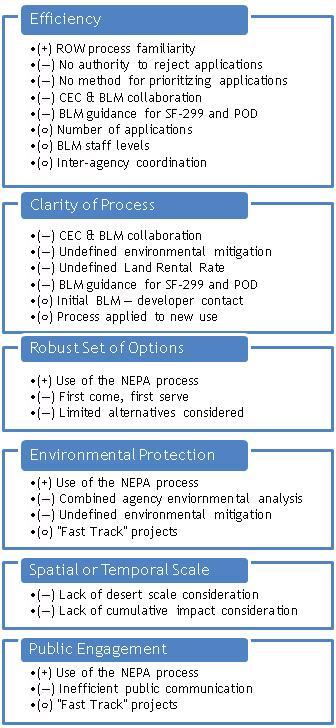Evaluation of the BLM Right-of-Way Process
As the BLM will be using the ROW process to evaluate proposed solar facilities, it is important that this process allows for siting decisions to made in a comprehensive and effective manner.

A critical analysis of the BLM's right-of-way process as it is applied to solar facilities was conducted using a set of normative criteria. Input from interviews, the stakeholder survey, and a survey of organizations supported our evaluation. The analysis determined whether the solar ROW process effectively addressed each of the criteria. The results of the analysis highlight the strengths and weaknesses of the process as well as considers other factors affecting processing. We have chosen to focus our evaluation and recommendations on the BLM ROW process since the agency is currently in the process of conducting a Solar PEIS, which will consider changes to the process. The analysis was conducted in order to inform and offer recommendations for improvement of the process for BLM staff, solar developers, and other interested and involved agencies and organizations. The CEC is not considering changes to their AFC process; therefore, their process is not analyzed. However, the integration of the BLM and CEC process was included in the analysis, as some changes to the BLM process may affect how the two processes integrate.
Two strengths and eleven weaknesses with the BLM process for siting solar facilities as it currently exists were identified (Table). When the Solar PEIS is released in draft and then in final form it may address some or all of these weaknesses, but these remain important as applications are processed in the meantime. Additionally, seven other factors were identified as affecting the processing of solar development applications. These are situational factors that are creating concerns and not weaknesses of the process itself. Most of these factors stem from the high level of interest in solar project development, which has generated a large number of solar ROW applications in a short time period in the California desert.
